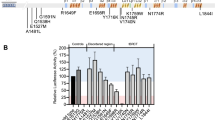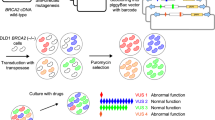Abstract
More than 75% of the reported mutations in the hereditary breast and ovarian cancer gene, BRCA1, result in truncated proteins. We have used the protein truncation test (PIT) to screen for mutations in exon 11, which encodes 61 % of BRCA1. In 45 patients from breast and/or ovarian cancer families we found six novel mutations: two single nucleotide insertions, three small deletions (1–5 bp) and a nonsense mutation identified two unrelated families. Furthermore, we were able to amplify the remaining coding region by RT–PCR using lymphocyte RNA. Combined with PTT, we detected aberrantly spliced products affecting exons 5 and 6 in one of two BRCA1–linked families examined. The protein truncation test promises to become a valuable technique in detecting BRCA1 mutations.
This is a preview of subscription content, access via your institution
Access options
Subscribe to this journal
Receive 12 print issues and online access
$209.00 per year
only $17.42 per issue
Buy this article
- Purchase on Springer Link
- Instant access to full article PDF
Prices may be subject to local taxes which are calculated during checkout
Similar content being viewed by others
References
Hall, J. et al. Linkage of early-onset familial breast cancer to chromosome 17q21. Science 250, 1684–1689 (1990).
Wooster, R. et al. Localization of a breast cancer susceptibility gene, BRCA2, to chromosome 13q12–13. Science 265, 2088–2090 (1994).
Easton, D.F. et al. Genetic linkage analysis in familial breast and ovarian cancer: Results from 214 families. Am. J. hum. Genet. 52, 678–701 (1993).
Ford, D. et al. Risks of cancer in BRCA1-mutation carriers. Lancet 343, 692–695 (1994).
Miki, Y. et al. Astrong candidate for the breast and ovarian cancer susceptibility gene BRCA1. Science 266, 66–71 (1994).
Lynch, H.T. et al. Genetic epidemiology of cancer (eds Lynch, H.T. & Hirayama, T.) 289–332 (CRC Press, Boca Baton, 1989).
Nowak, R. Breast cancer gene: many mutations make test difficult. Science 266, 1470 (1994).
Castilla et al. Mutations in the BRCA1 gene in families with early-onset breast and ovarian cancer. Nature Genet. 8, 387–391 (1994).
Futreal, P.A. et al. BRCA1 mutations in primary breast and ovarian carcinomas. Science 266, 120–122 (1994).
Simard, J. et al. Common origin of BRCA1 mutations in Canadian breast and ovarian cancer families. Nature Genet. 8, 392–398 (1994).
Friedman, L.S. et al. Confirmation of BRCA1 by analysis of germline mutations linked to breast and ovarian cancer in ten families. Nature Genet. 8, 399–404 (1994).
Shuttuck-Eidens, D. et al. A collaborative survey of 80 mutations in the BRCA1 breast and ovarian cancer susceptibility gene. J. Am. med. Assoc. 273, 535–541 (1995).
Roest, P.A.M., Roberts, R.G., Sugino, S., Van Ommen, G.J.B. & Den Dunnen, J.T. Protein truncation test (PTT) for rapid detection of translation-terminating mutations. Hum. molec. Genet. 2, 1719–1721 (1993).
Van Der Luit, R. et al. Rapid detection of translation-terminating mutations at the Adenomatous Polyposis Coli (APC) gene by direct Protein Truncation Test. Genomics 20, 1–4 (1994).
Powell, S.M. et al. Molecular diagnosis of Familial Adenomatous Polyposis. New Engl. J. Med. 329, 1982–1987 (1993).
Roberts, R.G., Barby, T.F.M., Manners, E., Bobrow, M. & Bently, D.R. Direct detection of dystrophin gene rearrangements by analysis of dystrophin mRNA in peripheral blood lymphocytes. Am. J. hum. Genet. 49, 298–310 (1991).
Narod, S.A. et al. A number of breast-ovarian cancer families appear to be unlinked to the BRCA1 locus on chromosome 17q. Am. J. hum. Genet. 56, 254–264 (1995).
Comelis, R.S. et al. Age at diagnosis as an indicator of eligibility for BRCA1 DNA-testing in familial breast cancer. Hum. Genet. 119, (in the press).
Miller, S.A., Dykes, D.D. & Polesky, H.F. A simple salting out procedure for extracting DNA from human nucleated cells. Nud. Acids Res. 16, 1215 (1988).
Author information
Authors and Affiliations
Rights and permissions
About this article
Cite this article
Hogervorst, F., Cornelis, R., Bout, M. et al. Rapid detection of BRCA1 mutations by the protein truncation test. Nat Genet 10, 208–212 (1995). https://doi.org/10.1038/ng0695-208
Received:
Accepted:
Issue Date:
DOI: https://doi.org/10.1038/ng0695-208
This article is cited by
-
Prediction of BRCA2-association in hereditary breast carcinomas using array-CGH
Breast Cancer Research and Treatment (2012)
-
BRCA1 and BRCA2 germline mutations in Uruguayan breast and breast–ovarian cancer families. Identification of novel mutations and unclassified variants
Breast Cancer Research and Treatment (2011)
-
A BRCA2 mutation incorrectly mapped in the original BRCA2 reference sequence, is a common West Danish founder mutation disrupting mRNA splicing
Breast Cancer Research and Treatment (2011)
-
Activated networking of platelet activating factor receptor and FAK/STAT1 induces malignant potential in BRCA1-mutant at-risk ovarian epithelium
Reproductive Biology and Endocrinology (2010)
-
Five recurrent BRCA1/2 mutations are responsible for cancer predisposition in the majority of Slovenian breast cancer families
BMC Medical Genetics (2008)



